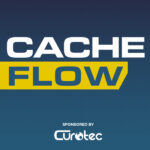Dive into the podcast world with Grain CEO Jeff Whitlock as we unravel Grain’s AI-driven meeting evolution, the merger that molded its future, and the star-studded story of Mike Adams. Get an insider’s look into raising VC funds, the trials of startup life, and the riveting roadmap that Grain’s cooking up, all topped off with some candid Silicon Valley talk.
Here are a few topics we’ll discuss on this episode of Cache Flow Podcast.
- Grain’s AI Transforms Note-taking.
- Grain and Startups’ Merger Insight.
- SaaS Frameworks vs. Intuition.
- Raising VC Funds: Pros & Cons.
- The Future Roadmap for Grain.
Resources:
Connect with Jeff Whitlock:
Connect with our host, Brian Dainis:
Quotables:
- 05:00 – Yeah, we had fun, fun that we thought that was fun. We joked to Mike, you’re famous, you’re old startup was mentioned in this show, but in his experience he kind of realized we’re doing a lot of these remote learning sessions. To be honest, this experience around recording them is not very good. And so that was kind of the initial gist of the idea. So it started, grain started off just very much as this idea that all these meetings are gonna be moving onto from kind of analog conversation, digital conversations, and there’s a lot of value in these meetings. We should make it a lot easier that for them to be, a lot easier to record and make them accessible and useful.
- 8:16 – And so, we made some tough mistakes I think during that period. Really important lesson for entrepreneurship is like, money doesn’t solve your problems. You know, I think we raised probably, I think when I first started entrepreneur, it was like, hey, if I can just raise that big round, success will be there and learn that that’s not true. In fact, too much money can cause its own problems. It causes you to kind of be a little lazy and try to cut corners and hire people to solve problems. And I’ve just learned, and we’ve just learned time and time again that like the founders have to at least come up with a solid V one on most most things. It is really hard to sort of outsource that.
- 10:33 – So we’ve had just a huge, huge number of new competitors join in that are kind of more like 2 to 3-year-old companies, whereas like the original ones like 4 to 5-year-old companies. So that’s been interesting to try to compete with them. And they often have like new fresh blood, fresh capital and, we’re still kind of going on and, that’s been a really interesting to kind of think about the strategic and market dynamics of our industry and one with like obvious value but not great moats. And so that’s been really interesting and not necessarily enough network effects for like there to be obvious winner take all quickly
- 23:16 – I would be much more, I’d say cautious in taking VC money. I think, I think when I started my entrepreneurial journey, I just like, this is the way you do it. You know, get an idea, you get a little bit early traction, you sweat equity and then once you can raise money you should raise money because then you can pay yourself and grow and blah, blah, blah. I think there was like a very much like this is the path and I didn’t consider many other paths. I would say if I were to do it again, obviously I think this time around I’d be in a position where I would have a little bit more starting capital and people who would maybe, maybe invest, but just as like, friends, family angels, which I didn’t have the first time around.
- 44:25 – Yeah, so the way I think about it is at a high level, well first of all there’s a strategy and the strategy is essentially, in my opinion, it’s defining where are you playing in the market and what’s your theory on how you’re going to capture the opportunity or win and that strategy should inform all your decisions then. So that’s kind of at the macro level. And we could talk more about strategy if you want how I think about it then you have, at the micro level, I have some kind of like broad based heuristics that kind of, we don’t perfectly follow, but they give you rough guidelines. So at this stage in grain, we spend about 80/20 or 75/25 we call offense and defense. Offense are features that we feel are like moving the product forward and going to help us get new business either, either by selling new people, getting more people to convert or maybe getting more people to upgrade. So it’s like going to build the business and make it go forward.





